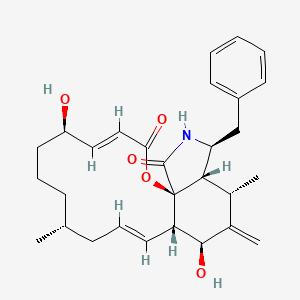| MeSH term | MeSH ID | Detail |
|---|---|---|
| Granulomatous Disease, Chronic | D006105 | 4 associated lipids |
| Leukemia, Erythroblastic, Acute | D004915 | 41 associated lipids |
| Melanoma | D008545 | 69 associated lipids |
| Asthma | D001249 | 52 associated lipids |
| Kidney Diseases | D007674 | 29 associated lipids |
| Glioma | D005910 | 112 associated lipids |
| Cell Transformation, Neoplastic | D002471 | 126 associated lipids |
| Lymphoma | D008223 | 18 associated lipids |
| Alzheimer Disease | D000544 | 76 associated lipids |
| Thyroid Neoplasms | D013964 | 33 associated lipids |
CYTOCHALASIN B
CYTOCHALASIN B is a lipid of Polyketides (PK) class. Cytochalasin b is associated with abnormalities such as Renal tubular disorder and Chagas Disease. The involved functions are known as Membrane Protein Traffic, inhibitors, Metabolic Inhibition, Biochemical Pathway and Increased Sensitivy. Cytochalasin b often locates in Cytoplasmic matrix, Plasma membrane, Microtubules, Extracellular and Protoplasm. The associated genes with CYTOCHALASIN B are SLC2A2 gene, PFDN5 gene, SLC2A1 gene, OMG gene and SPEN gene. The related lipids are Steroids, Lipopolysaccharides and Liposomes. The related experimental models are Xenograft Model.
Cross Reference
Introduction
To understand associated biological information of CYTOCHALASIN B, we collected biological information of abnormalities, associated pathways, cellular/molecular locations, biological functions, related genes/proteins, lipids and common seen animal/experimental models with organized paragraphs from literatures.
What diseases are associated with CYTOCHALASIN B?
CYTOCHALASIN B is suspected in Renal tubular disorder, Chagas Disease and other diseases in descending order of the highest number of associated sentences.
Related references are mostly published in these journals:
| Disease | Cross reference | Weighted score | Related literature |
|---|
Possible diseases from mapped MeSH terms on references
We collected disease MeSH terms mapped to the references associated with CYTOCHALASIN B
PubChem Associated disorders and diseases
What pathways are associated with CYTOCHALASIN B
There are no associated biomedical information in the current reference collection.
PubChem Biomolecular Interactions and Pathways
Link to PubChem Biomolecular Interactions and PathwaysWhat cellular locations are associated with CYTOCHALASIN B?
Visualization in cellular structure
Associated locations are in red color. Not associated locations are in black.
Related references are published most in these journals:
| Location | Cross reference | Weighted score | Related literatures |
|---|
What functions are associated with CYTOCHALASIN B?
Related references are published most in these journals:
| Function | Cross reference | Weighted score | Related literatures |
|---|
What lipids are associated with CYTOCHALASIN B?
Related references are published most in these journals:
| Lipid concept | Cross reference | Weighted score | Related literatures |
|---|
What genes are associated with CYTOCHALASIN B?
Related references are published most in these journals:
- Am. J. Physiol., Cell Physiol. (2)
- Am. J. Physiol. Renal Physiol. (1)
- Biochim. Biophys. Acta (1)
- Others (8)
| Gene | Cross reference | Weighted score | Related literatures |
|---|
What common seen animal models are associated with CYTOCHALASIN B?
Xenograft Model
Xenograft Model are used in the study 'Endofacial competitive inhibition of the glucose transporter 1 activity by gossypol.' (Pérez A et al., 2009).
Related references are published most in these journals:
| Model | Cross reference | Weighted score | Related literatures |
|---|
NCBI Entrez Crosslinks
All references with CYTOCHALASIN B
Download all related citations| Authors | Title | Published | Journal | PubMed Link |
|---|---|---|---|---|
| Hosseini SM et al. | Chemically assisted somatic cell nuclear transfer without micromanipulator in the goat: effects of demecolcine, cytochalasin-B, and MG-132 on the efficiency of a manual method of oocyte enucleation using a pulled Pasteur pipette. | 2015 | Anim. Reprod. Sci. | pmid:25956201 |
| Simic MR et al. | Synthesis of novel tetrahydrobenzazepine derivatives and their cytoprotective effect on human lymphocytes. | 2015 | Arch. Pharm. (Weinheim) | pmid:25664628 |
| Jiang P et al. | Rapamycin promoted thrombosis and platelet adhesion to endothelial cells by inducing membrane remodeling. | 2014 | BMC Cell Biol. | pmid:24564184 |
| Seidensticker M et al. | Tumor cell uptake of 99mTc-labeled 1-thio-β-D-glucose and 5-thio-D-glucose in comparison with 2-deoxy-2-[18F]fluoro-D-glucose in vitro: kinetics, dependencies, blockage and cell compartment of accumulation. | 2014 | Mol Imaging Biol | pmid:24065199 |
| Yan Z et al. | Transcriptional and posttranscriptional regulation and endocytosis were involved in zinc oxide nanoparticle-induced interleukin-8 overexpression in human bronchial epithelial cells. | 2014 | Cell Biol. Toxicol. | pmid:24554449 |
| Kong X et al. | Glucagon-like peptide 1 stimulates insulin secretion via inhibiting RhoA/ROCK signaling and disassembling glucotoxicity-induced stress fibers. | 2014 | Endocrinology | pmid:25243854 |
| Sripunya N et al. | Cytochalasin B efficiency in the cryopreservation of immature bovine oocytes by Cryotop and solid surface vitrification methods. | 2014 | Cryobiology | pmid:25224047 |
| Luebben SW et al. | Methods for the detection of genome instability derived from replication stress in primary mouse embryonic fibroblasts. | 2014 | Methods Mol. Biol. | pmid:25064113 |
| Awad WA et al. | Mechanisms underlying the inhibitory effect of the feed contaminant deoxynivalenol on glucose absorption in broiler chickens. | 2014 | Vet. J. | pmid:25011710 |
| Brouillette MJ et al. | Strain-dependent oxidant release in articular cartilage originates from mitochondria. | 2014 | Biomech Model Mechanobiol | pmid:23896937 |
